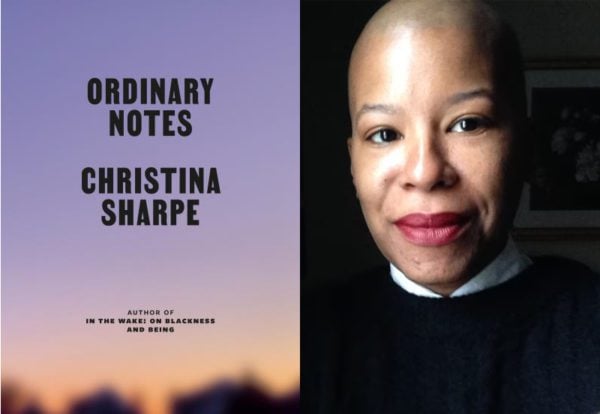
To read Christina Sharpe’s latest book, Ordinary Notes, is to enter into a kind of willed seduction. Sharpe’s delicate facility with language, tone, and rhythm, and her ability to articulate the achingly inarticulable, are, in many ways, irresistible. Delivered in sparse, lyrical sentences that hold both the sublime and the harrowing in taught balance, the author’s gifts of insight and analysis have few peers in recent writing.
Building on her enormously influential book, In the Wake: On Blackness and Being, published in 2016, this new volume continues the scholar’s examination of contemporary Black life, revealing how it is marred and constrained by white supremacy within the afterlife of slavery. Sharpe’s project is to mine difficult terrain, to unearth and conjure language that signifies how – despite daunting and life-altering realities – Black people insist on living meaningful, loving, generative, and beautiful lives. “I write these ordinary things to detail the everyday sonic and haptic vocabularies of living life under these brutal regimes,” she writes.
Structured across eight sections, 248 discursive notes grapple with weighty subjects: lynching, death (physical and social), trauma, family breakdown, police killings, and the unceasing interdictions of Black freedom. In plumbing themes of loss, memory, fear, and anti-Black racism, Sharpe exhibits a deft ability – like Saidiya Hartman, bell hooks, and other Black feminist writers before her – to engage with complex theories drawn from reservoirs of personal and communal experience. Literature, art, scholarly works, media, current events, photography, writers, politicians, and family relations are all brought into meditations that range from poignant one-line observations to lengthy passages interspersed with photographs.
Sharpe’s work addresses that which truncates and harms Black life. It does not, in equal measure, explore what restores or what promises hope, evidencing a recent strain in Black studies that takes up nihilism to work out what is at its core an abolitionist framework. But it is Sharpe’s uncanny ability to meticulously and sensitively unveil the toxic underside of the banal that makes this book a singular achievement. “I want to tell how sorrow makes a shape that is familiar. And how that familiar thing can be difficult both to name and to narrate,” she writes.
The familiar and familial are exquisitely rendered in the sections about Sharpe’s late mother, Ida Wright Sharpe. These loving and tender notes act as the book’s fulcrum, around which all of the author’s witnessing and thinking circle. Sharpe’s relationship with her mother provides a window on how she developed her particular way of seeing. “I wanted to write about silences and terror and acts that hover over generations, over centuries. I began by writing about my mother and grandmother.” Seeing “beauty as a method” Sharpe recounts how her mother gave her the gifts of observation and discernment. “I learned to see in my mother’s house. I learned how not to see in my mother’s house. How to limit my sight to the things that could be controlled. I learned to see in discrete angles, planes, plots. If the ceiling was falling down and you couldn’t do anything about it, what you could do was grow and arrange peonies and tulips and zinnias; cut forsythia and mock orange to bring inside.”
Amid searing reflections on grief, angst, and palpable outrage at the conditions Black people endure, there are moments of joy. Sharpe’s writing can be melancholic, but it is not without glimpses of beauty and possibility, even if these are fleeting. In Note 80, for example, she writes movingly about seeing a young girl while looking out from a subway car. “The girl leans forward as she walks, and the strap of her school bag is slung across her forehead, the bag hangs down her back. This tenderness in what I have seen.” It is this inward-looking, observational writing where the notes sing; it is when Sharpe writes of Black people busy in their own worlds, in their own self-love and care – when what white people think, say, or do in relation to Black people is temporarily moved outside the frame – that her writing does its most powerful work.
In wanting to show how urgent and serious the stakes are for Black people, Sharpe’s writing can become overburdened by its purpose. She wants the reader to know – to really know and feel – that white supremacy is all encompassing, that it is, and always will be, foundational to modern life, even when she has repeatedly made this point. Sharpe spends a considerable amount of time (maybe too much time) slaying white dragons, even dead ones. In Note 124, for example, she writes that French cultural theorist Roland Barthes would not have been able to see beauty in Black portraits – “[He] would never consider the word elegance in relation to that photo of James VanDerZee’s family. Or mine.” It is an observation so obvious it need not be stated.
It is worth pointing out that Sharpe writes within and specifically about the U.S. milieu. Accordingly, her point of view, her references – locales, politics, and history – limit Ordinary Notes from being a diasporic work. She does not have much to say, for example, about Black experience in the Caribbean, or in Europe, Latin America, or Africa. The moody registers in which Sharpe’s notes resound are distinctly American and perhaps miss out on sonic pulses and accents rooted in the humour, satire, ribaldry, and languor of Black life found elsewhere. But this does not diminish a work that haunts and lingers in the way all penetrating books do
 Contact us via email
Contact us via email

